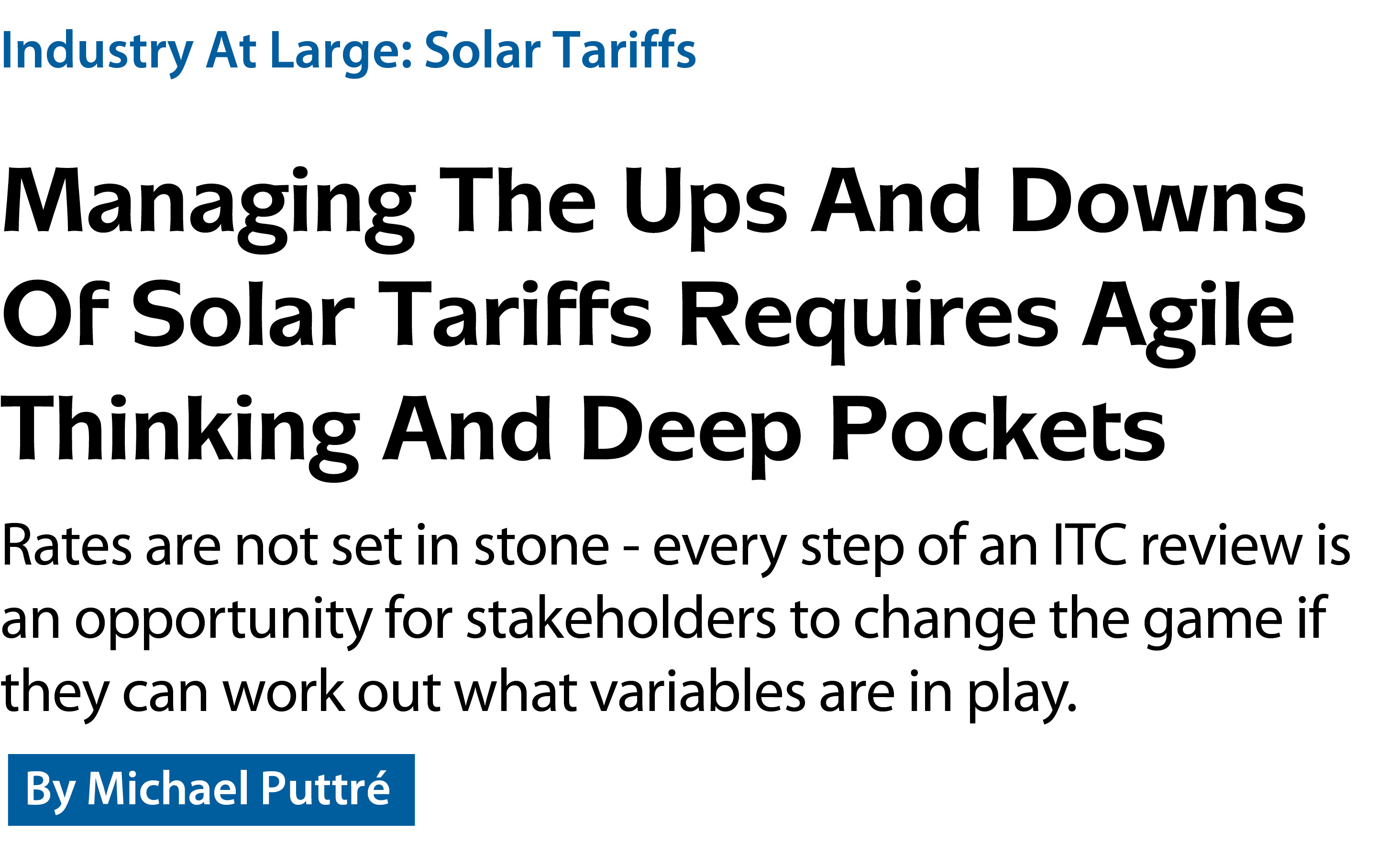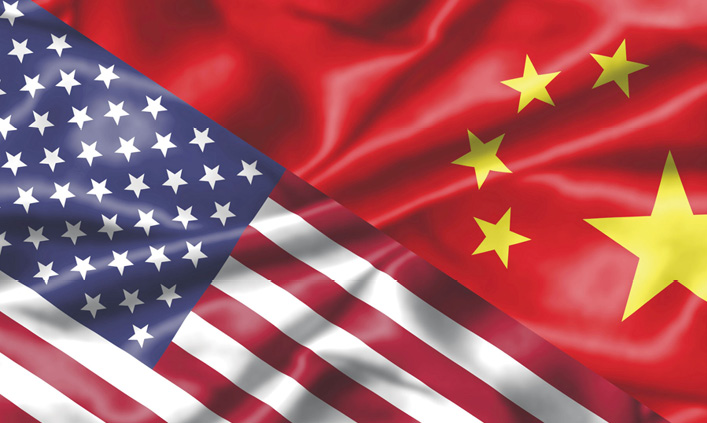

301 Moved Permanently
On Jan. 21, the U.S. International Trade Commission (ITC) voted to uphold the tariffs proposed last year on imports of solar photovoltaic products from China and Taiwan. These tariffs range up to over 50%, depending on the product and manufacturer of origin.
“We are deeply disappointed with the tariff decision by U.S. ITC; it will have a detrimental effect on the Taiwan solar industry,” says Davis Chen, chairman and CEO of WINAICO, a manufacturer of PV modules. “But the Taiwan solar industry shall rethink our go-to market strategies and invest in channel management.”
Rethinking market strategies and managing channels can actually have a major impact on tariff duty rates. Witness the year-end decision by the U.S. Department of Commerce (DOC) to reduce the tariff rates from an earlier anti-dumping trade case against China from an average of 31% to 18%. Thus, the rate at one point of the process may change dramatically at another.
What brings the rates down is not so much back-room deals or legal maneuvers but parties trying to control their risk through their pricing and other tweaks to their commercial behavior.
Bernd Janzen, a partner in the international trade practice of Akin Gump in Washington, D.C., says that in many cases, parties learn to manage their exposure a little bit better to bring their rates down. “In an investigation, everybody is pretty much walloped on the respondent side,” he says. “Over time, you can plan pricing and commercial behavior in a way to try to mitigate the duty risk.”
Helpfully, legal experts involved in the raft of solar trade cases involving the U.S. and China have broadly divided those stemming from the 2012 investigations as Solar I and those arising out of the investigations launched last year as Solar II. In both sets of cases, SolarWorld Americas filed a complaint alleging anti-competitive trade practices on the part of China-sourced photovoltaic products. The main distinction between them is that the scope of the Solar II cases also includes products manufactured or assembled in Taiwan from components originating in China.
According to Janzen, who represents importers of PV products affected by the tariffs, there is nothing all that surprising about these latest rates stemming from the Solar I case being lower than the rates determined in the investigation. “In the Solar I administrative review, which we have just seen the preliminary results of review, you could say that it is consistent with an overall trend you see in many cases where, over time, rates tend to come down somewhat,” he says.
The caveat here is that the rates are always a function of DOC methodologies. Each number that the DOC spits out in each determination is the result of lots of distinct calculations and methodological calls. There is a lot of analysis and calculation going into each one of those numbers. The DOC’s methodologies and approaches evolve over time, and there are many judgment calls embedded in each determination that are heavily litigated.

“In every investigation and in every administrative review, the parties file arguments encouraging the DOC to do it this way or that way,” Janzen says. “The petitioner - the U.S. producer - of course, is always arguing for Commerce to use its discretion in a way that increases rates, while the respondent interested parties are trying to do the opposite.”
The challenge for stakeholders in trade investigations and tariff calculations is figuring out what variables are in play. The DOC’s methodologies also evolve over time. The way they look at a particular issue can sometimes change. That is also something that can impact rates.
“Within this larger trend line of rates tending to go down over time, you can also see changes in methodology that could cause a rate to spike back up,” Janzen says. “The rate we just saw in this preliminary result of administrative review - the combined roughly 18 percent rate - could be higher in the final result of review that will be issued this summer. Could be the same. Could be a little lower. Could be higher.”
An administrative review is a more detailed follow-on analysis of what the DOC looked at initially in the investigation. Although many industry stakeholders call for a negotiated settlement, Janzen says there really is no room for negotiation. Rather, the results are a function of the factual record and how the facts are interpreted and what legal tests and standards those facts go through.
“There have been separate settlement discussions between the U.S. government and China,” he says. “But those have not been successful to date. At this point, the administrative proceedings at the Commerce Department will just continue on for the foreseeable future.”
The same analytic process that produced the revised rates for the Solar I cases in all likelihood will apply to the Solar II cases also. The real difference between Solar I and Solar II is the scope of the merchandise that is covered due to the inclusion of PV products from Taiwan. However, in terms of the methodologies that the DOC applies to measure alleged subsidies and to measure alleged dumping, that’s pretty much the same.
“They gather the same kind of data, and they do the same legal analysis; it’s just a different time period and a different set of products because of the scope of coverage being different,” Janzen says.
At the same time, although the parties involved in the Solar II case can expect tariff rates to follow a similar trajectory to those from Solar I, this will not occur without internal changes to business procedures coupled with strenuous and ongoing legal arguments.
Looking back
There was never any real drama about whether or not dumping was going to be found, and many blame the investigation process. William Perry, international trade partner at Dorsey & Whitney in Seattle, says the very mechanism of the DOC’s investigation process is preordained to produce a finding of dumping against China when it comes to PV products.
There is a special anti-dumping investigation used for countries specified as non-market economies. That methodology typically leads to higher rates. The state of U.S. trade law is that China is still treated as a non-market economy for anti-dumping purposes. That means that for the foreseeable future, non-market methodology will apply.
Always, the drama hinged on whether SolarWorld might be induced to drop its case in exchange for a negotiated settlement. Although the Solar Energy Industries Association (SEIA) has tried to serve as an intermediary between the two sides, SolarWorld and its allies disputed the organization’s status as an honest broker.
Predictably, the case would not be dropped, and the investigation came to an inevitable conclusion. The question now is what effects the decision - fair or not - will have.
Although some manufacturers of photovoltaic solar products feel satisfied by the DOC’s decision to impose anti-dumping tariffs in the Solar II case, others say the decision is likely to do significant harm to the U.S. solar sector.
“This new overreaching determination simply makes things worse,” says Jigar Shah, president of the Coalition for Affordable Solar Energy (CASE). “It directly punishes U.S. solar manufacturers, such as Suniva - a company that the tariffs were supposedly intended to help. Instead, the company faces import duties because their U.S.-manufactured solar cells are assembled into modules in China.”
Boiling the issue down, the two points of contention are as follows:
- Supporters of the trade case say U.S. manufacturing is being damaged by subsidized Chinese imports; and
- Opponents of the trade case say most of the U.S. solar sector is based on inexpensive panels, and a tariff on Chinese imports hurts the needs of the many.
Tim Larrison, vice president at Yingli Green Energy Americas, told an audience at Intersolar North America in San Francisco last July that tariffs on Chinese solar cells are not only imposing additional costs on PV generation, but also squelching innovation by reducing research and development budgets and preventing new technologies from reaching key markets, particularly in the U.S.
“The irrational behavior [on tariffs] has been shocking to me,” Larrison said, especially given the volumes of PV products large Chinese manufacturers represent. “It’s not a good idea to kill the supplier. You need your supplier for the 25 years of the warranty.”
Some developers and installers says solar trade issues are having a real impact on business.
“Prices for solar systems are inching up,” says Jaymes Callinan, president of commercial solar installation firm Vista Solar. “In the few weeks since the tariffs were announced, we’ve seen prices from module suppliers increase by about 6 percent.”
According to Callinan, the real question is not how much the cost of panels will rise, but how availability will be affected. Although he does not anticipate supply issues in 2015, he says Vista Solar has seen a major uptick in interest from clients who are moving to secure panels before the final tariff decision.
“Since the beginning of this dispute, CASE has said tariffs will slow the growth of the overall U.S. solar industry by raising the cost of solar power for consumers,” Shah says. “It’s clearer than ever that we need free and fair trade, not restrictive tariffs, for the continued growth of America’s solar industry and lower prices for consumers.”
Going forward
On the bright side, the adjustment of the tariff rates in the Solar I case should have a positive impact on the U.S. solar sector. It also offers hope for those who would like to see the rates reduced in the Solar II case, as well. At the same time, the rates in both cases may be seen as works in progress - with much of that work being on the legal front.
“Lowering the tariff import tax means more U.S. consumers will be able to afford solar power, and more American solar companies will be able to expand their hiring,” Shah says. “Although this is positive news, it does not solve the underlying problem. The U.S. solar industry remains unfairly penalized by a trade policy that inflates the cost of solar power and has already expanded to include imports from Taiwan.”
Rhone Resch, president and CEO of SEIA, remains hopeful that some kind of negotiated settlement might be possible as an alternative to continuous litigation extending into the foreseeable future.
“There is, however, a clear path forward - one which will help SolarWorld, restore U.S. polysilicon and boost the U.S. solar industry overall,” Resch says, in a statement. “That path involves a negotiated solution, recognizing broader industry interests. We’re not talking about an unrealistic minimum price regime or unreasonable quotas - and certainly not a two-tiered minimum pricing scheme. Rather, it’s a solution which addresses U.S.-China competitiveness concerns, directly benefits U.S. solar cell and module manufacturers, and allows the broader U.S. solar industry to reach its full potential.”
Industry At Large: Solar Tariffs
Managing The Ups And Downs Of Solar Tariffs Requires Agile Thinking And Deep Pockets
By Michael Puttré
Rates are not set in stone - every step of an ITC review is an opportunity for stakeholders to change the game if they can work out what variables are in play.
si body si body i si body bi si body b
si depbio
- si bullets
si sh
si subhead
pullquote
si first graph
si sh no rule
si last graph